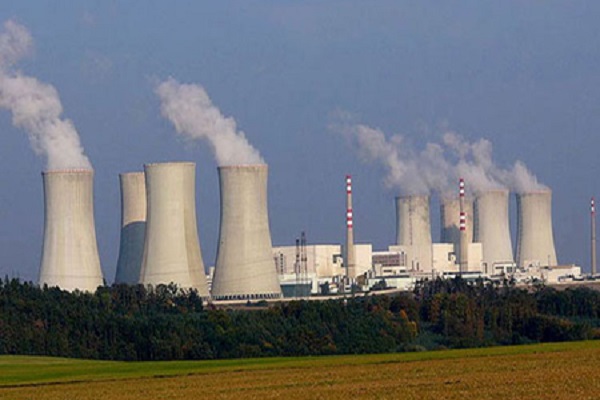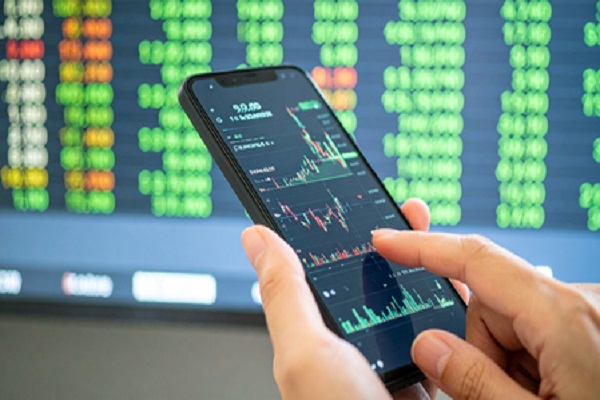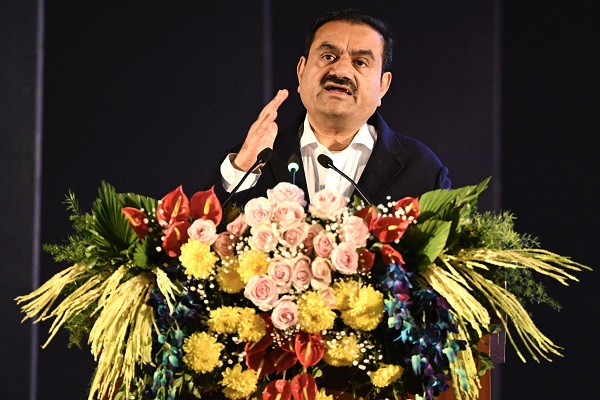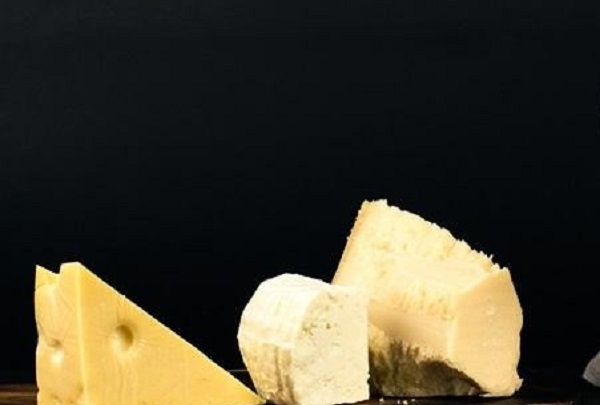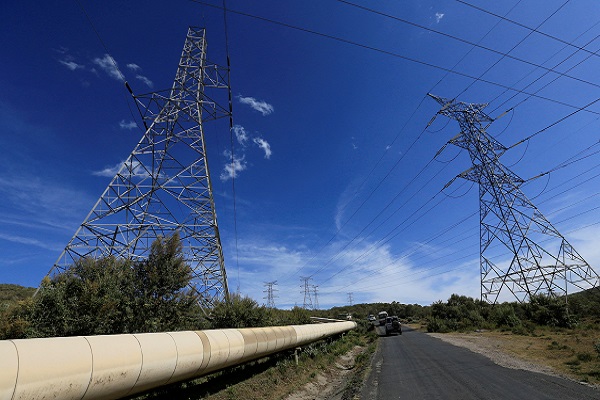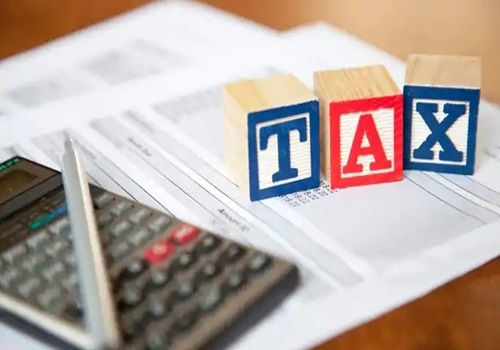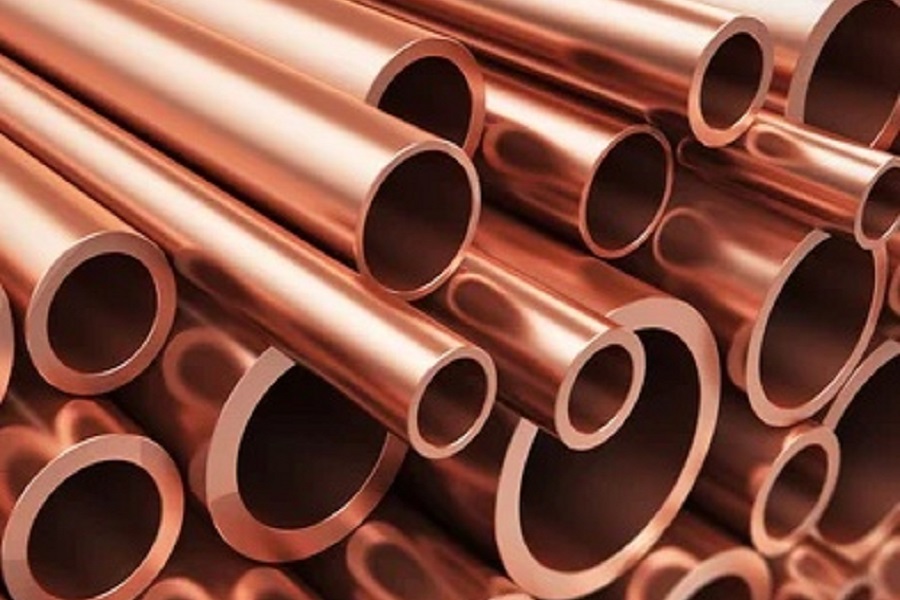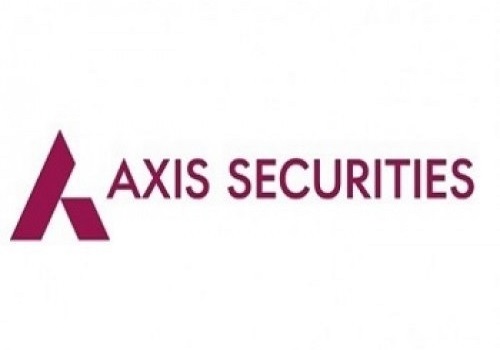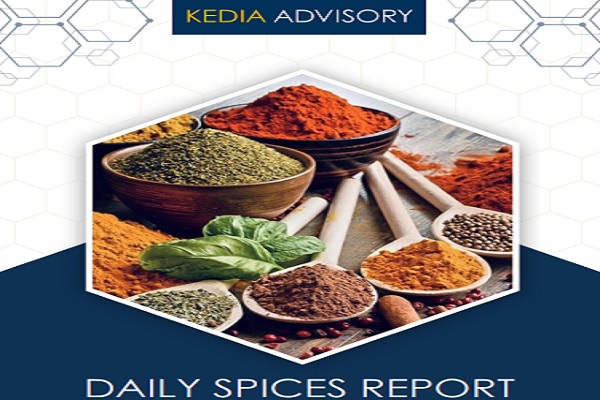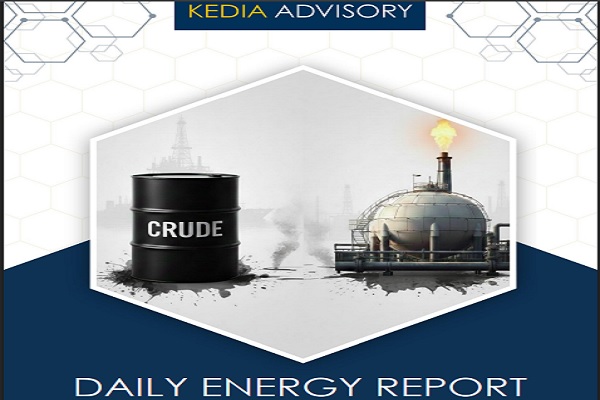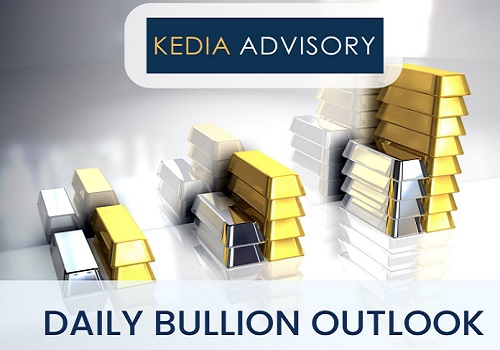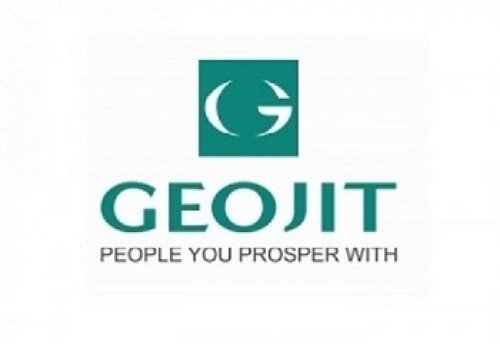Jeera trading range for the day is 19460-19740 - Kedia Advisory

Gold
Gold settled higher by 0.59% at 97,788 as investors digested fresh U.S. inflation data and awaited further clarity on U.S. President Donald Trump’s evolving trade policy. U.S. consumer prices rose in June by the most in five months, reflecting tariff impacts and raising the possibility that the Federal Reserve may hold interest rates steady until at least September. Dallas Fed Bank President Lorie Logan reinforced this cautious stance, suggesting rates may stay unchanged to manage tariff-driven inflation pressures. According to CME FedWatch Tool, markets now see a 59.9% probability of a rate cut in September, while the Fed is expected to keep rates at 4.25%–4.50% in July. Meanwhile, global central bank demand stayed firm, with net gold purchases of 20 tonnes in May led by Kazakhstan, Turkey, Poland, and Singapore. On the physical side, demand in major Asian markets remained tepid as volatile prices dampened buying interest. Chinese dealers maintained solid premiums of $10–$25 per ounce over global benchmarks, while Indian market discounts narrowed to up to $8 an ounce due to tight supplies and limited scrap availability during the monsoon lull. Technically, gold is under short covering with open interest down 0.9% to 10,624 while prices gained 577. Immediate support is at 97,160 and a break below may test 96,530, while resistance is pegged at 98,350, with a move above likely to push prices towards 98,910.
Trading Ideas:
* Gold trading range for the day is 96530-98910.
* Gold prices edged higher as investors digested economic data showing an increase in U.S. consumer prices.
* U.S. consumer prices increased in June by the most in five months amid higher costs for some goods.
* India's June gold imports fall to two – year low as record price dents demand.
Silver
Silver settled marginally higher by 0.13% at 1,11,635 as the US dollar and Treasury yields eased from recent highs, giving precious metals room to recover. The retreat came as investors digested comments from Dallas Fed President Lorie Logan, who reiterated the need for a prolonged hold on US interest rates to curb inflation, especially as new tariff threats from President Trump loom over pharmaceuticals and semiconductors starting August 1. Domestically, silver’s appeal remains robust with strong investment inflows—Indian silver ETFs attracted 39.25 billion in the June quarter, significantly surpassing the 23.67 billion that flowed into gold ETFs during the same period. Retail investment demand in India rose 7% in the first half of 2025, boosted by expectations of sustained price gains. India’s silver imports also reflect this appetite, surging 431% year-on-year in May to 544.1 tons and nearly doubling in June compared to last year. On the global front, silver ETPs attracted net inflows of 95 million ounces in the first half of 2025, already exceeding total 2024 inflows. Holdings rose to 1.13 billion ounces by June, just 7% below the all-time high in February 2021. Technically, silver is under short covering as open interest fell 4.35% to 17,849 while prices gained 149. Immediate support lies at 1,10,855 and a drop below may test 1,10,080. Resistance is likely at 1,12,350, with a break above opening the door for a test of 1,13,070.
Trading Ideas:
* Silver trading range for the day is 110080-113070.
* Silver prices gained as the US dollar and Treasury yields retreated from recent highs.
* US producer prices were unchanged in June from May 2025, following an upwardly revised 0.3% rise in the previous period.
* Investors reassessed the Federal Reserve’s policy outlook and monitored shifting trade dynamics.
Crude oil
Crude oil closed unchanged at 5,713 as the market balanced mixed cues around supply, demand, and geopolitical developments. Persistent concerns about President Trump’s escalating trade tariffs continued to weigh on sentiment amid fears that slower global growth could dampen fuel demand in the months ahead. Adding to supply-side worries, OPEC+ reiterated plans to keep gradually raising output, heightening the risk of a potential oversupply later this year. However, signs of strong seasonal fuel demand, particularly from the US and China, lent support to prices as summer travel picks up and economic conditions show improvement. OPEC’s latest outlook expects global growth to strengthen in the second half of 2025, driven by robust performance in India, China, and Brazil, alongside recoveries in the US and EU. In the US, peak summer driving season and tight diesel inventories have also underpinned prices. Supply disruptions added to the supportive undertone, with a drone strike in northern Iraq forcing DNO ASA to halt some production. Meanwhile, Russia’s oil output fell 3.5% year-on-year in the first five months of 2025, which could tighten the global supply balance marginally. US crude oil inventories dropped by 3.859 million barrels last week, although gasoline and distillate stocks posted significant builds of 3.399 million and 4.173 million barrels, respectively. Technically, crude oil is under fresh selling pressure with open interest rising by 2.37% to 7,393 while prices stayed flat. Immediate support is seen at 5,648; a drop below could test 5,582. Resistance is placed at 5,765, and a break above may push prices towards 5,816.
Trading Ideas:
* Crudeoil trading range for the day is 5582-5816.
* Crude oil prices eased amid worries that Trump’s trade tariffs could curb global growth and fuel demand
* OPEC+ plans to continue raising output, stoking concerns of an oversupplied oil market later this year.
* OPEC’s latest report sees stronger global growth in H2 2025, led by India, China, Brazil, and US
Natural gas
Natural gas settled marginally lower by 0.3% at 302.4 as forecasts for milder weather over the next two weeks eased concerns over sustained high cooling demand. This softer outlook offset bullish signals from rising gas flows to US LNG export terminals, which have rebounded strongly in July after maintenance outages. LNG feedgas averaged 15.8 billion cubic feet per day (bcfd) so far this month and was set to hit a three-month high of 16.6 bcfd on Monday, indicating healthy export demand. Meanwhile, updated forecasts still show warmer conditions across the Lower 48 states, supporting above-average cooling needs in the near term. On the storage front, US utilities injected 53 bcf into storage for the week ending July 4, in line with the five-year average but below last year’s 61 bcf build for the same period. Total gas inventories now stand at 3.006 trillion cubic feet, about 6.1% above the seasonal average, reflecting comfortable supply. The EIA’s latest outlook remains supportive for the medium term, projecting record-high dry gas production of 105.9 bcfd in 2025, up from 103.2 bcfd in 2024, with output set to climb further in 2026. Technically, the market is under long liquidation as open interest dropped by 4.28% to 17,554 while prices eased by 0.9. Immediate support is pegged at 299.2; a break below could test 296.1. Resistance is seen at 307.3, with a move above likely to push prices towards 312.3.
Trading Ideas:
* Naturalgas trading range for the day is 296.1-312.3.
* Natural gas eased on forecasts for less hot weather over the next two weeks
* Average gas flows to the eight major US LNG export plants reached 15.8 bcfd so far in July.
* LNG feedgas was set to hit a three-month high of 16.6 bcfd on Monday’s estimates.
Copper
Copper settled lower by 0.32% at 881.25 as momentum in redirecting shipments to the US slowed ahead of the impending 50% tariff on copper imports announced by President Trump, set to take effect on August 1. This policy shift aims to boost domestic production and reduce reliance on foreign refined copper. The anticipated tariff has already caused a notable drop in requests for copper withdrawals from London Metal Exchange warehouses, weighing on global copper flows. Currently, the US produces just over half of its refined copper needs, with Arizona contributing over two-thirds of domestic output, while more than 90% of imports come from Chile, Canada, and Peru. Meanwhile, Goldman Sachs expects LME copper prices to edge lower to $9,550 per metric ton in August, maintaining its long COMEX-LME arbitrage recommendation as the market continues to underprice the tariff risk. On the supply side, Chile’s Codelco reported a 9% year-on-year rise in output for H1 2025, while Antofagasta’s production grew 11% to 314,900 metric tons, with full-year guidance unchanged at 660,000–700,000 tons. Production cost efficiencies have helped Antofagasta cut net cash costs by 32% to $1.32 per pound. The ICSG reported a 50,000 metric ton global refined copper deficit in April, compared to a surplus in March, although the year-to-date surplus remains sizeable. Technically, copper is under long liquidation as open interest dropped by 3.32% to 6,211 while prices slipped by 2.8. Immediate support is seen at 879.5, with a break below opening the door to 877.7. Resistance is placed at 883.2; a move above this could lift prices towards 885.1.
Trading Ideas:
* Copper trading range for the day is 877.7-885.1.
* Copper declined as the momentum to redirect global shipments to the US slowed ahead of looming tariffs.
* LME copper stocks gained by another 10,525 tons, having jumped by a third over the past 2-1/2 weeks.
* Chilean miner Antofagasta said its copper production rose 11% to 314,900 metric tons in the first half of 2025
Zinc
Zinc settled marginally higher by 0.02% at 256.45, finding some support as China’s economy showed resilience in Q2 despite lingering concerns about weak manufacturing demand. China’s GDP grew by 5.2% year-on-year in the April–June quarter, slightly above market expectations of 5.1%, but slower than the 5.4% growth seen in Q1. While the trade truce allowed factories to front-load shipments ahead of new tariffs, investors remain cautious about softer exports, falling prices, and persistently low consumer confidence that could weigh on zinc demand in the second half of the year. Meanwhile, inventories at warehouses monitored by the Shanghai Exchange rose 10.20% from last Friday, reflecting tepid demand and ample supply. On the supply side, Teck Resources’ Red Dog Mine, the world’s largest zinc mine, reported a 20% annual drop in output in Q1 to 145,300 tonnes as it nears depletion. Additionally, Australian smelter Nyrstar plans to cut output by 25% this year due to ore shortages and uncompetitive treatment charges. Globally, the zinc surplus narrowed to 16,000 metric tons in April from 23,400 tons in March, according to the ILZSG. China’s refined zinc production dropped 1% month-on-month in May but rose about 2% year-on-year, with cumulative output for January–May up only 0.5% YoY, falling short of expectations due to maintenance shutdowns across major regions. Technically, zinc is under fresh buying as open interest rose by 4.02% to 2,663 while prices gained 0.05. Immediate support is at 255.1, with a drop below testing 253.6, while resistance is pegged at 257.5; a break above could lift prices towards 258.4.
Trading Ideas:
* Zinc trading range for the day is 253.6-258.4.
* Zinc settled flat as China’s economy slowed less than expected in the second quarter.
* China’s policy support and front-loaded exports cushioned growth, but weaker second-half outlook weighs on sentiment.
* Shanghai Futures Exchange zinc inventories rose sharply by 10.20% from last Friday, highlighting sluggish factory demand.
Aluminium
Aluminium settled slightly lower by 0.12% at 248.15 as rising inventories and lingering trade tensions weighed on market sentiment. Global risk appetite remains subdued amid uncertainty over the impact of fresh U.S. tariffs and renewed geopolitical concerns. In China, economic data showed resilience with Q2 GDP slowing less than expected and June industrial output up 6.8% year-on-year. However, falling new home prices and a pivot towards sustainable urban growth signal structural shifts that could dampen construction-related aluminium demand in the long run. Inventories monitored by the Shanghai Exchange rose 9.1% from last Friday, while LME warehouse stocks have surged by 47,450 tonnes since late June to 384,350 tonnes, flipping the cash premium to a discount, indicating ample near-term supply. Export volumes remained mixed; China’s unwrought aluminium exports dropped to 489,000 tonnes in June from 547,000 tonnes in May, reflecting softer overseas demand. In Japan, major buyers agreed to a sharply lower premium of $108 per metric ton for Q3 shipments, down 41% from Q2, amid high inventories and weak consumption, although stocks at three major Japanese ports slipped 4.3% in June. Technically, aluminium is under long liquidation with open interest down by 1.56% to 2,780 while prices edged down by 0.3. Immediate support is seen at 247.6 and a break below could push prices towards 246.9. Resistance is pegged at 248.9, with a move above likely to lift prices to 249.5.
Trading Ideas:
* Aluminium trading range for the day is 246.9-249.5.
* Aluminium dropped as inventories continued rising amid uncertainty about the impact of U.S. tariffs.
* Pressure also seen amid renewed global trade tensions dampened risk appetite.
* China's aluminium production rose by 3.4 % to 3.81 million metric tons in June from a year earlier
Cottoncandy
Cottoncandy settled slightly higher by 0.47% at 55,700 as short covering emerged after prices had dropped earlier due to a significant increase in India’s closing stock estimates for the 2024–25 season. According to the Cotton Association of India (CAI), closing stocks are projected at 55.59 lakh bales, up 84% from last year’s 30.19 lakh bales, driven by a higher crop size. The CAI has revised pressing estimates for the season upward to 311.40 lakh bales from 301.14 lakh bales, lifting total supply till end-June to 356.76 lakh bales, including 30 lakh bales of imports. Consumption till end-June stood at 233.5 lakh bales, while exports remained muted at 15.25 lakh bales, leading to substantial stocks of 108.01 lakh bales, with large volumes still held by traders, CCI, and mills. Notably, domestic consumption for the full season is marginally higher at 308 lakh bales, but exports are projected to fall sharply by 40% to 17 lakh bales compared to last year’s 28.36 lakh bales. Imports are estimated to more than double to 39 lakh bales, with 30 lakh bales already landed by June-end. Globally, the U.S. balance sheet for 2025/26 indicates higher production and ending stocks, while the world balance sheet also points to increased output, especially from China and Mexico, with global ending stocks raised by 520,000 bales. In Rajkot, spot prices slipped marginally by 0.11% to 27,544.75. Technically, Cottoncandy is under short covering with unchanged open interest at 65 and prices up by 260. Immediate support is seen at 55,500, with a break below testing 55,300. Resistance is pegged at 55,900, and a move above may lift prices towards 56,100.
Trading Ideas:
* Cottoncandy trading range for the day is 55300-56100.
* Cotton gains on short covering after prices dropped as 2024-25 closing stocks seen 84% higher at 55.59 lakh bales
* CAI cut consumption forecast by 8 lakh bales to 307 lakh for the 2024–25 season.
* Cotton exports expected to fall to 15 lakh bales, down 13.36 lakh from last year.
* In Rajkot, a major spot market, the price ended at 27544.75 Rupees dropped by -0.11 percent.
Turmeric
Turmeric settled lower by 1.68% at 13,324 amid expectations of higher acreage due to favourable monsoon conditions supporting timely sowing. Daily arrivals increased to 13,660 quintals from 11,940 quintals in the previous session, suggesting marginally higher market availability. For the 2024-25 season, the area under turmeric has expanded to 3.30 lakh hectares, about 10% higher than last year’s 3 lakh hectares. However, production gains may not match acreage growth, as untimely rains could hurt yields. Last season’s output was around 10.75 lakh tonnes, but this year’s crop is expected to see 10–15% lower yields due to small rhizomes and crop rot in regions like Nanded. Despite these concerns, fresh arrivals at the Duggirala market continue to attract strong buying interest, with new stocks fetching higher prices than old inventory due to better quality. So far, nearly 50–55% of the new crop has been traded, with robust market activity likely to persist until the end of June. Export performance remains supportive, with April 2025 shipments rising 6% year-on-year to 14,956.80 tonnes, although they dipped slightly by 0.92% compared to March 2025. Meanwhile, the Himachal Pradesh government has initiated procurement drives to boost natural farming. In the spot market at Nizamabad, turmeric prices slipped 0.17% to 14,102.6. Technically, turmeric is under fresh selling pressure with open interest up 2.18% to 17,845 while prices fell 228. Immediate support is seen at 13,198; a break below may test 13,074. Resistance is pegged at 13,548, and a move above this could push prices towards 13,774.
Trading Ideas:
* Turmeric trading range for the day is 13074-13774.
* Turmeric prices dropped due to expected increase in acreage.
* Turmeric acreage is expected to increase by 15-20% this season, supported by low competitive crop prices.
* In April 2025 around 14,956.80 tonnes were exported as against 14,109.10 tonnes in April 2024 showing a rise of 6%.# In Nizamabad, a major spot market, the price ended at 14102.6 Rupees dropped by -0.17 percent.
Jeera
Jeera settled lower by 0.79% at 19,430 as weak domestic and overseas demand weighed on prices following the end of the peak retail season. Traders attributed the price decline to subdued buying from foreign markets and adequate existing stocks fulfilling the current export requirements. Farmers are reportedly holding about 20 lakh bags of jeera, out of which only 3–4 lakh bags are expected to be traded by season-end, leaving a sizable carry-forward stock of nearly 16 lakh bags. Comfortable supply and a lack of aggressive buying interest are keeping upside limited. However, the downside is capped by the outlook for strong export demand in the medium term and easing geopolitical concerns, which could revive trade flows. The 2024–25 production is projected at around 90–92 lakh bags, slightly lower than last year’s 1.10 crore bags, due to a slight reduction in sowing area. Gujarat’s production is estimated at 42–45 lakh bags and Rajasthan’s at 48–50 lakh bags. On the global front, adverse weather has trimmed China’s cumin output estimate to 70–80 thousand tonnes from an earlier projection of 1 lakh tonnes. In exports, India shipped about 19,719.60 tonnes of jeera in April 2025, down 48.11% year-on-year but up 13.74% compared to March 2025. Technically, jeera remains under fresh selling pressure with open interest rising 9.23% to 6,282 while prices fell by 155. Immediate support lies at 19,330; a break below could test 19,230. Resistance is seen at 19,580, and a move above may push prices towards 19,730.
Trading Ideas:
* Jeera trading range for the day is 19230-19730.
* Jeera dropped due to weak domestic and export demand post retail season.
* However downside seen limited on strong export demand and easing geopolitical concerns.
* Total arrivals witnessed a marginal increase to 12,000 bags (55 kg each) as against 11,800 bags on the previous day.
* In Unjha, a major spot market, the price ended at 19983.9 Rupees dropped by -0.14 percent.
Views express by all participants are for information & academic purpose only. Kindly read disclaimer before referring below views
